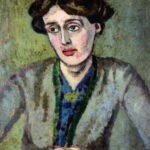Bipolar Disorder is a mental illness that causes people to have severe mood swings that deeply affect relationships, careers, and the general quality of life of those who have it. This disorder is the sixth leading cause of disability in the U.S. today (Nusslock, 2007). According to the National Institute of Mental Health, almost six million Americans adults today suffer from Bipolar Disorder, and, though treatable, often goes unrecognized (McClung, 2007). Virginia Woolf, 1882-1941, may be one of the most famous historical cases of bipolar disorder. Her modernist works such as Mrs. Dalloway are still studied extensively today by college literature students. Her unique style of writing, which came to be known as “stream of consciousness,” was largely influenced by the symptoms she experienced though her disorder, although the illness was not understood in her lifetime (Carmango, 1992).
Many of today’s Americans have heard the word “bipolar,” but do not realize its full implications. People who know someone with this disorder might often interpret their erratic behavior as a character flaw, not realizing that people with this mental illness do not have control over their moods. Many people use the word casually to describe people whose moods change quickly, but this interpretation is not accurate. These misconceptions may be partly due to the illness not being understood well until recent decades. Up until the early seventies, “manic depressive psychosis,” as it was called then, was thought to be a rare condition on which not much research had been focused. Other psychotic symptoms were often lumped into this category, and people who would have qualified for today’s standards of Bipolar Disorder were often misdiagnosed as having Schizophrenia (Mitchell, 2006).
Most people have appropriate levels of high and low depending on the situations and experiences they face on a day-to-day basis. When someone buys a new house, they might work constantly for several days without much rest and feel excited about all they are getting done. A person who has lost a loved one may feel very low for several weeks or even a few months. These are examples of a situationally appropriate high and low. An individual who suffers from Bipolar Illness, however, would likely feel an extreme high or low for no particular reason, for an extended period of time, sometimes even with psychotic symptoms such as delusions and hallucinations (NIMH, 2007).
The style in which Virginia Woolf wrote seemed to bring together the different perspectives through which she perceived the world through her cycles of psychotic highs, psychotic lows, and sanity. It is important to note that there is a large difference between manic psychosis and depressive psychosis.
Woolf recognized that the manic state stimulated her already rich imagination to create and project fictions that had little basis in reality but that explained (or at least embodied, if obscurely) her experienced moods… (Carmango, 1992).
In contrast, when reality would hit the morning after one of these mystical, even joyful visions, severe depressive psychosis could hit.
At times like this, one suffering from this illness might “lie in bed, immobile, despondent, completely helpless in the face of despair and guilt” (Carmango, 1992). In her early years, starting at age thirteen, she would alternate from one to the other during her most severe attacks, but just before her suicide was the only time when the severe psychotic depression hit her without the elevated state of mania.
In a Manic Episode, most people have a hard time showing up for work, yet they often spend large amounts of money. They barely sleep, and some become sexually promiscuous or engage in other risky behavior. Because they feel invincible, they are not cognizant of the conequences of their actions. Yet consequences do catch up with them, and one can imagine how difficult it would be to achieve career goals with this type of disruption occurring on a regular basis (DSM IV-TR).
A Hypomanic Episode carries the same symptoms as a Manic Episode, but less sever (DSM IV-TR). A typical manic phase might include the following symptoms: excessive energy, euphoria, feeling restless or irritable, racing thoughts, irrational or impulsive behavior, delusions of grandeur, and sometimes even aggression or drug abuse. According to the Diagnostic and Statistical Manual of Mental Disorders IV-TR, to classify as a manic episode characteristic of Bipolar Disorder, three or more symptoms must persist for at least a one week period (DSM IV-TR).
Depressive episodes have very different symptoms, as described in the DSM IV-TR. For at least a two-week period, a person would feel intolerably sad, lack energy, lose pleasure in activities they previously enjoyed, and might even have problems sleeping or eating. Some people have trouble just motivating themselves to get out of bed. They may also have physical aches such as headaches or nausea that stem from the depression, also known as somatic symptoms (DSM IV-TR). Many depressive episodes last longer than two weeks. Although some people are very good at disguising their symptoms, a person going through a depressive episode could be recognized if their friends, families, and co-workers take the time to notice changes in attitudes and behaviors (NIMH, 2007).
Another type of episode that some individuals with Bipolar Disorder experience is called a Mixed Episode. To meet the DSM IV-TR criteria for one of these episodes, a person would meet the criteria for both a Manic and a Mixed Episode simultaneously, for a period of one week or more. Psychotic symptoms may or may not be involved (DSM IV-TR, 2000). A person experiencing a Mixed Episode might feel excited and euphoric, but not have the energy to get out of bed. (NIMH, 2007).
There are two main types of Bipolar Disorder, Bipolar I Disorder and Bipolar II Disorder. Bipolar I involves at least one occurrence of either a Manic or Mixed Episode. Many people with Bipolar I may also have a Major Depressive Episode (MDE), but the difference between this diagnosis and Bipolar II is that for Bipolar II, an MDE is not necessary. For a Bipolar II diagnosis, there must be at least one MDE as well as at least one Manic or Hypomanic Episode (DSM IV-TR).
Several theories exist as to what might lead a person to develop bipolar disorder. In Virginia Woolf’s case, many scholars related her illness to childhood sexual abuse by her older step brothers, on the basis of Freudian theory. Freud’s ideas were becoming popular around the same time as Woolf’s literature, and many believed her mental breakdowns stemmed from her abuse, the death of her mother and brother, and her father’s patriarchal control (Carmango, 1992). It is difficult to determine whether or not the abuse played a role in the development of her Bipolar Illness because it is not typically considered a reaction to environmental factors such as abuse. Depression and Post-Traumatic Stress Disorder are often correlated with childhood sexual abuse, but Neither of these include symptoms of the severe manic episodes and mood cycles that Virginia showed from a young age (DSM IV-TR, 2000).
Some research theorizes that it is more likely that Virginia developed her Bipolar Illness because of genetic family influences. Current research shows that those who have relatives with a mood disorder are more likely to develop mood disorders themselves. In studies of identical twins, Bipolar Illness is likely to affect both people, but the fact that is does not happen every time shows that there are other important factors that determine each individual’s mental health. However, according to NIMH, there is not one specific gene that determines whether or not someone will be bipolar or not. Evidence seems to show that “many different genes work together, and in combination with other factors of the person or the person’s environment, to cause bipolar disorder”(NIMH, 2007). There are many current studies being conducted to determine which genes may be factors. (NIMH, 2007)
In one such study, researchers at UT Southwestern found that a gene referred to as the Clock gene, which controls the circadian rhythms, may be linked to Bipolar Illness. By disrupting the clock gene in mice, the animals displayed symptoms similar to people experiencing a manic episode (McClung, 2007). They infer that, “The episodes of mania and depressionin bipolar disorder generally develop a regular periodicity,often linked to the seasons of the year. Within an episode, disrupted circadian rhythms including sleep- wake cycle,hormonal secretions, and diurnal variation in mood are evident.”(McClung, p.6) This research suggests that a possible treatment course for Bipolar patients could include adhering to a very stable sleep pattern (McClung, 2007).
Another factor that may be involved not in the development of the disorder, but of the onset of episodes, may be a stressful “goal-striving” life event. Researchers at the University of Wisconsin, Madison, studied the effect that college final examinations had on students with Bipolar Disorder. They found that students were very likely to experience the onset of a hypomanic or manic episode during the course of their finals. Not all students had the same types of episodes, but the act of striving toward a goal did tend to set off their symptoms in some way. (Nusslock, 2007). One Bipolar student commented that “I am most up when I am working toward something, when I am out of my rut, because I love to tackle the impossible…” (Nusslock, 108). This feeling may be part of the reason that Virginia Woolf experienced such a high from writing. If viewed as a goal-striving event, the act of writing may have actually triggered her manic episodes. This knowledge is helpful because it can help people with this disorder learn to be aware of what situations will be likely triggers so they can be sure to regulate their sleep patterns, be aware of their moods, and be better able to manage their illness (Nusslock, 2007).
In recent study at Brown University, researchers attempted to find a correlation between family functioning and the course of Bipolar Disorder (Uebelacker, 2006). It was concluded that poor family functioning was related to the onset of episodes. However, a family member’s episode could be a cause of poor family functioning. The causal relationship is difficult to determine because of how much family functioning can fluctuate in a given time period. The main benefit of this research was that Bipolar individuals whose families participated in family therapy had higher family functioning than those who did not. Whether it is causal or not, stable family relationships would likely make it easier for Bipolar family members to manage their symptoms (Uebelacker, 2006). In Woolf’s case, family problems may have played a major role, not in the development of her disease, but in the onsets of her episodes. In fact, her first episode occurred after the death of an older brother when she was in her teens. Surely this would have had a large effect on the functioning of her family (Carmango, 1992).
Because of the emphasis on Bipolar Disorder in recent, years, professionals now have several different treatment options that have been considered successful for most patients. Not all people receiving a specific treatment will react the same way, so different methods are needed to treat the needs of the individuals suffering from this disorder. Research in the area of treatment for this illness suggests that medication is necessary for treating Bipolar Disorder, but that a combination of drugs and psychosocial treatment may be the best approach. While drugs alone may have the same initial effect as a combination, the psychosocial treatment seems to prevent relapse in later years (Miklowitz & Otto, 2006).
Unfortunately, patients who suffer from rapid-cycling Bipolar Disorder (quickly alternating manic and depressive episodes), seem most likely to commit suicide (Findling, 2005). These people are more likely to have severe symptoms with a predominance of depression, and may experience onset at an earlier age. (Antai-Otong, 2006). Judging by her history, it seems that this is likely the type of Bipolar Disorder that Woolf suffered from. Sadly, like many of these individuals, her story ended in suicide. Luckily, there have been research breakthroughs in treating cases of this type of bipolar disorder, as well as other. It is very important that professionals who treat Bipolar clients take care to fully assess the case history of each person before deciding on a treatment strategy. Every person is different, and making sure that they are treated as individuals and given the right type of care depending on their needs can be the difference between life and death.
References
American Psychiatric Association. (2000). Diagnostic and Statistical Manual of Mental Disorders, Fourth Edition, Text Revision. Washington, D.C.: American Psychiatric Association.
Antai-Otong, D. (2006) The Art of Prescribing: Treatment considerations for patients experiencing rapid-cycling bipolar disorder.
Carmango, Thomas. (1992). The Flight of the Mind: Virginia Woolf’s Art and Manic Depressive Illness. Berkeley, CA: University of California Press.
Findling, R.L. (2005). Early symptoms of mania and the role of parental risk. Bipolar Disorders, 7. 623-634.
McClung, C.A., Nestler, E.J., Takahashi, J.S., Carlezon, W. A., et al. (2007). Mania-like behavior induced by disruption of CLOCK. Proceedings of the National Academy of Sciences of the United States of America. 4, 6097-6098.
Mitchell, P.B. (2006). Bipolar Disorder 40 years ago: A critical period of transition. Australian and New Zealand Journal of Psychiatry. 40, 279-280.
Miklowitz, D. G. and Otto, M.W. (2006). New Psychosocial Interventions for Bipolar Disorder: A review of literature and introduction of the systematic treatment enhancement program. Journal of Cognitive Psychotherapy. 20, 214-230.
National Institute of Mental Health. (2007) Bipolar Disorder. Bethesda, M.D.: US Department of Health And Human Services.
Nusslock, R., Abramson, L.Y., Harmon-Jones, E., Alloy, L.B., et al. (2007) A Goal-Striving Life Event and the Onset of Hypomanic and Depressive Episodes and Symptoms: Perspective From the Behavioral Approach System (BAS) Dysregulation Theory. Journal of Abnormal Psychology. 116, 105-115.
Uebelacker, L. A., Miller, I. W., Keitner, G. I., Ryan, C., & Solomon, D. A. (2006). The impact of family treatment on family functioning in Bipolar I disorder. Journal of Family Psychology. 20, 701-704.




